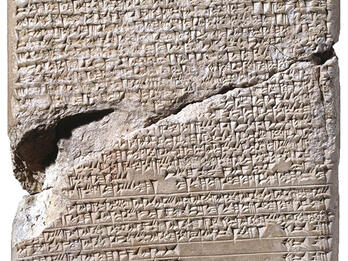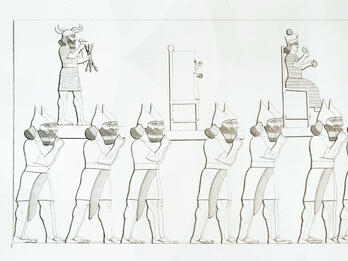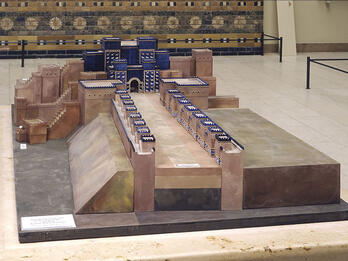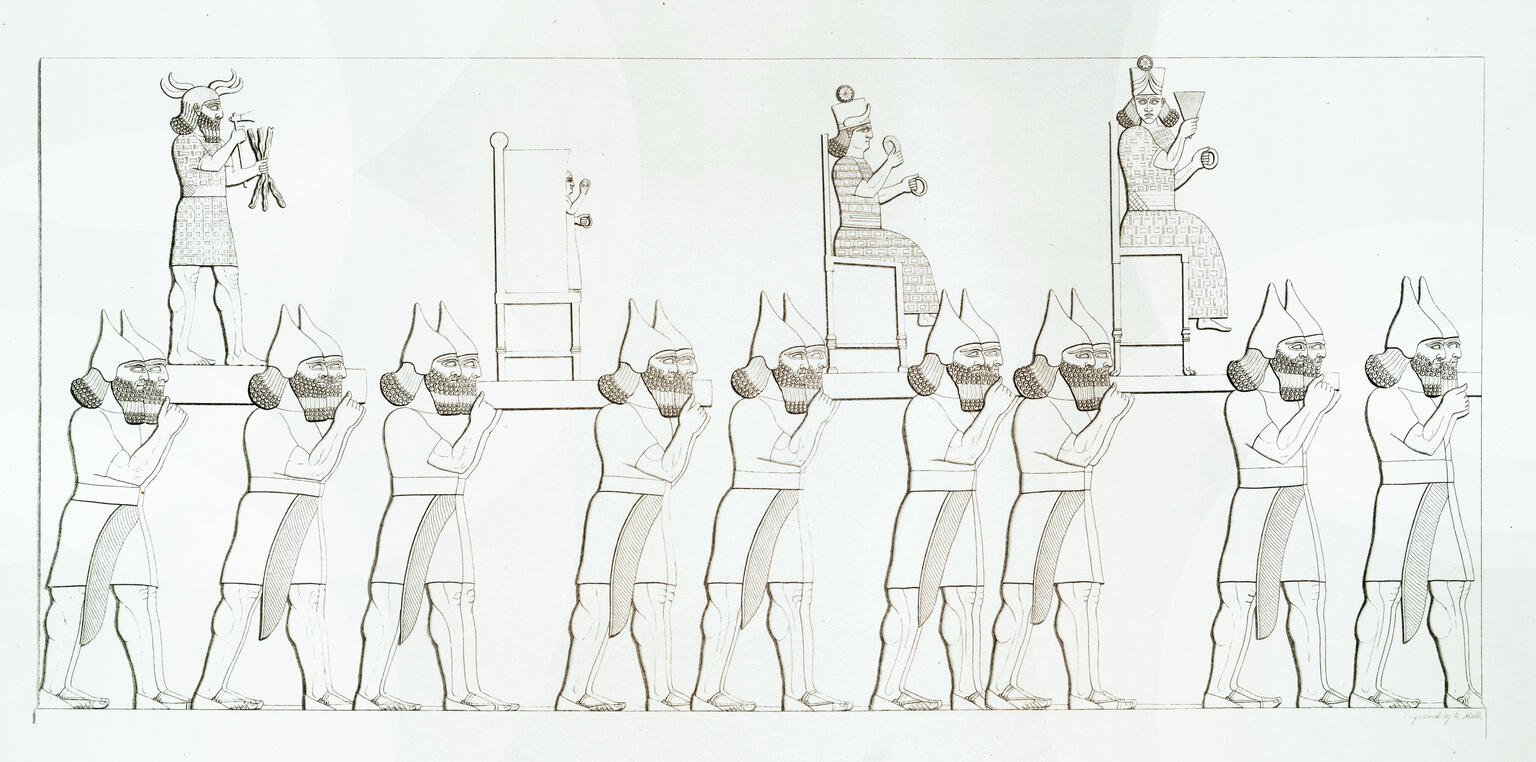God Speaks to Cyrus
Isaiah 45:1, 5–7
Biblical Period
1Thus said the Lord to Cyrus, His anointed one—
Whose right hand He has grasped,
Treading down nations before him, [ . . . ].
5I am the Lord and there is none else;
Beside Me, there is no god.
Whose right hand He has grasped,
Treading down nations before him, [ . . . ].
5I am the Lord and there is none else;
Beside Me, there is no god.
I engird you, though you have not known Me,
6So that they may know, from east to west,
That there is none but Me.
I am the Lord and there is none else,
7I form light and create darkness,
I make weal and create woe—
I the Lord do all these things.
Cult statues in Assyrian relief from the Palace of Tiglath-pileser III (reigned 745–727 BCE) in Kalhu/Calah (today’s Nimrud, Iraq). Although no Mesopotamian cult statues have been found, reliefs such as this one show what they looked like. Here, Assyrian soldiers carry statues of deities away from a defeated city. The drawing was made at the site by Austin Henry Layard, the archaeologist who found the relief. The association between military defeat and carrying off the victims’ cult statues is seen in Isaiah 46:1–2 and in the description of their restoration in the Cyrus Cylinder.
Credits
Reprinted from Tanakh: The Holy Scriptures by permission of the University of Nebraska Press. Copyright 1985 by the Jewish Publication Society, Philadelphia.
Published in: The Posen Library of Jewish Culture and Civilization, vol. 1.
You may also like

Idol-quickening Instructions
Idol-quickening instructions, Babylonia, 6th century BCE. The “mouth-washing” ritual was a ceremony for transforming a newly manufactured idol into a living deity. The instructions include these…

Cult statues in Assyrian relief
Cult statues in Assyrian relief from the Palace of Tiglath-pileser III (reigned 745–727 BCE) in Kalhu/Calah (today’s Nimrud, Iraq). Although no Mesopotamian cult statues have been found, reliefs such…

Babylon Degraded and Punished
Get down, sit in the dust,
Fair Maiden Babylon;
Sit, dethroned, on the ground,
O Fair Chaldea;
Nevermore shall they call you
The tender and dainty one.
Zion will Welcome Back Her People
Shout, O heavens, and rejoice, O earth!
Break into shouting, O hills!
For the Lord has comforted His people,
And has taken back His afflicted ones in love. [ . . . ]
Swiftly your children are…

Ishtar Gate and Processional Avenue
Ishtar Gate and processional avenue, Babylon. This scale model in the Pergamon Museum in Berlin shows the splendor of the city in the days of the prophet—or prophets—whose words are preserved in…
A Message of Hope to the Judeans
Listen to Me, you who pursue justice,
You who seek the Lord:
Look to the rock you were hewn from,
To the quarry you were dug from.
Look back to Abraham your father
And to Sarah who brought you…
Engage with this Source
Related Guide
From Isaiah to Zechariah: Biblical Prophets
Biblical Period
The classical prophetic books of the Hebrew Bible include many poetic or highly rhetorical prophecies addressed to the public at large.
Related Guide
Isaiah and the Call for Monotheism
Biblical Period
The book of Isaiah has two sections, one the voice of Isaiah ben Amoz, an eighth-century BCE prophet in Jerusalem, and the other an anonymous Judean prophet of the Babylonian exile.
You may also like

Idol-quickening Instructions
Idol-quickening instructions, Babylonia, 6th century BCE. The “mouth-washing” ritual was a ceremony for transforming a newly manufactured idol into a living deity. The instructions include these…

Cult statues in Assyrian relief
Cult statues in Assyrian relief from the Palace of Tiglath-pileser III (reigned 745–727 BCE) in Kalhu/Calah (today’s Nimrud, Iraq). Although no Mesopotamian cult statues have been found, reliefs such…

Babylon Degraded and Punished
Get down, sit in the dust,
Fair Maiden Babylon;
Sit, dethroned, on the ground,
O Fair Chaldea;
Nevermore shall they call you
The tender and dainty one.
Zion will Welcome Back Her People
Shout, O heavens, and rejoice, O earth!
Break into shouting, O hills!
For the Lord has comforted His people,
And has taken back His afflicted ones in love. [ . . . ]
Swiftly your children are…

Ishtar Gate and Processional Avenue
Ishtar Gate and processional avenue, Babylon. This scale model in the Pergamon Museum in Berlin shows the splendor of the city in the days of the prophet—or prophets—whose words are preserved in…
A Message of Hope to the Judeans
Listen to Me, you who pursue justice,
You who seek the Lord:
Look to the rock you were hewn from,
To the quarry you were dug from.
Look back to Abraham your father
And to Sarah who brought you…




